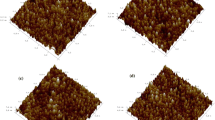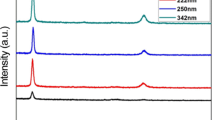Abstract
Spatial uniformity in thickness and other characteristics over the surface of thin films plays a fundamental role in characterization and device fabrication particularly in the solar cells. We report an investigation in the preparation of zinc oxide (ZnO) thin film on sapphire substrate by RF magnetron sputtering and characterization by spectral reflectance, photoluminescence, transmittance, and atomic force microscopy measurements. Surface of the film is spatially analyzed and a comparison is established with the previously reported results of metal organic chemical vapor deposition (MOCVD) grown ZnO film. Results show that ZnO films prepared by sputtering technique are superior in thickness uniformity for practical applications. Optical quality of the films prepared by sputtering is similar or even shows better quality compared to the films grown by MOCVD. Furthermore, the importance of film thickness uniformity in particular with reference to the solar cell performance is discussed that, so far, could not draw adequate attention from the research community.






Similar content being viewed by others
References
E. Fortunato, P. Barquinha, R. Martins, Oxide semiconductor thin-film transistors: a review of recent advances. Adv. Mater 24, 2945–2986 (2012)
H. Tampo et al., Polarization-induced two-dimensional electron gases in ZnMgO/ZnO heterostructures. Appl. Phys. Lett. 93, 202104 (2008)
K. Remashan, Y.S. Choi, S.J. Park, J.H. Jang, High performance MOCVD-grown ZnO thin-film transistor with a thin MgZnO layer at channel/gate insulator interface. J. Electrochem. Soc 157, H1121–H1126 (2010)
B. Hussain, B. Kucukgok, M.Y.A. Raja, B. Klein, N. Lu, I.T. Ferguson, Is ZnO as a universal semiconductor material an oxymoron?, in Proc. Of SPIE vol. 8987, pp. 898718, (2014)
S. J. Henley, M. N. R. Ashfold, D. Cherns, The growth of transparent conducting ZnO films by pulsed laser ablation, Surf. Coat. Tech. 177–178, 271–276, (2004)
Tsukazaki et al, High electron mobility exceeding 104 cm2V–1 s–1 in MgxZn1–xO/ZnO single heterostructures grown by molecular beam epitaxy. Appl. Phys. Express 1, 055004, (2008)
T. Yamada, H. Makino, N. Yamamoto, T. Yamamoto, Ingrain and grain boundary scattering effects on electron mobility of transparent conducting polycrystalline Ga-doped ZnO films. J. Appl. Phys 107, 123534, (2010)
B. Hussain, M. Y. A. Raja, N. Lu, and I. Ferguson, Applications and synthesis of zinc oxide: an emerging wide bandgap material. Proc. IEEE 10th International HONET Conference, pp. 88–93, (2013)
X. Yu et al., Preparation and properties of ZnO:Ga films prepared by r.f. magnetron sputtering at low temperature, Appl. Surf. Sci., 239, 222–226, (2005)
S.H. Mohamed, M. Raaif, Effects of thickness and rf plasma oxidizing on structural and optical properties of SiOxNy thin films. Surf. Coating Technol. 205, 525–532 (2010)
N. Choudhary, D.K. Kharat, D. Kaur, Structural, electrical and mechanical properties of magnetron sputtered NiTi/PZT/TiOx thin film heterostructures. Surf. Coating Technol. 205, 3387–3396 (2011)
B. Hussain, Improvement in open circuit voltage of n-ZnO/p-Si solar cell by using amorphous-ZnO at the interface, under review
P. Mishra, R. Patel, B. Hussain, J. Stansell, B. Kucukgok, M. Y. Raja, N. Lu, and I. Ferguson, “Spatial analysis of ZnO thin films prepared by vertically aligned MOCVD,” Proc. IEEE 10th International HONET Conference, doi:10.1109/HONET.2014.7029363, (2014)
P. Mishra, B. Monroe, B. Hussain, I. Ferguson, Temperature optimization for MOCVD-based growth of ZnO thin films, Proc. IEEE 10th International HONET Conference, doi:10.1109/HONET.2014.7029400, (2014)
W.I. Park, S.J. An, G.C. Vi, H.M. Jang, Metal-organic vapor phase epitaxial growth of high-quality ZnO films on Al2O3(001). J. Mater. Res. 16, 1358–1362 (2001)
Z.C. Feng, “MOCVD growth of ZnO nanostructures on sapphire” In Handbook of Zinc Oxide and Related Materials, 2nd Ed., (CRC Press, Boca Raton, FL, 2012), pp. 3–53
T. M. Khan, T. Bibi, B. Hussain, Synthesis and optical study of heat-treated ZnO nanopowder for optoelectronic applications, Bull. Mater. Sci. 38, 1851–1858, (2015)
Stadler, Transparent conducting oxides—an up-to-date overview. Materials, 5, 661–683, (2012)
E. Chanta et al., Effect of ZnO double layer as anti-reflection coating layer in ZnO dye-sensitized solar cells. Energy Procedia 79, 879–884 (2015)
B. Hussain, A. Ebong, I. Ferguson, Zinc oxide as an active n-layer and antireflection coating for silicon based heterojunction solar cell. Solar Energy Mater. Solar Cells 139, 95–100 (2015)
Z. Yichen, S. Qingzhu, S. Zhulai, Research on thin film thickness uniformity for deposition of rectangular planar sputtering target. Physics Procedia 32, 903–913 (2012)
G. Gaspar et al., Identification of defects causing performance degradation of high temperature n-type Czochralski silicon bifacial solar cells. Solar Energy Mater. Solar Cells 153, 31–43 (2016)
Y.O. Choi, N.H. Kim, J.S. Park, W.S. Lee, Influences of thickness-uniformity and surface morphology on the electrical and optical properties of sputtered CdTe thin films for large-area II–VI semiconductor heterostructured solar cells. Mater. Sci. Eng. B 171, 73–78 (2010)
V.G. Karpov, A.D. Compaan, D. Shvydka, Effects of nonuniformity in thin-film photovoltaics. Appl. Phys. Lett. 80, 4265–4258 (2002)
Acknowledgements
We are thankful to the reviewers of this paper for their help to improve the quality and clarity of presentation. We are grateful to Drs. Edward Stokes and Young Zhang (both from UNCC) for letting us use their equipment to measure thickness, transmission, and photoluminescence. Babar Hussain is thankful to Dr. Michael Fiddy (UNCC) for useful discussions and also to Dr. Lou Deguzman and Hanin Elathram (both from UNCC) for their technical help. This work has been partially funded by College of Engineering at UNC Charlotte.
Author information
Authors and Affiliations
Corresponding author
Rights and permissions
About this article
Cite this article
Ortiz, T., Conde, C., Khan, T.M. et al. Thickness uniformity and optical/structural evaluation of RF sputtered ZnO thin films for solar cell and other device applications. Appl. Phys. A 123, 280 (2017). https://doi.org/10.1007/s00339-017-0909-2
Received:
Accepted:
Published:
DOI: https://doi.org/10.1007/s00339-017-0909-2




